CBSE Sample Papers for Class 12 Chemistry Set-4
Class 12thCBSE Sample Papers for Class 12 Chemistry Set-4
CBSE Sample Papers for Class 12 Chemistry Set 4 with Solutions
Time: 3 hrs
Max. Marks: 70
General Instructions
Read the following instructions carefully.
- There are 33 questions in this question paper with internal choice.
- Section A consists of 16 multiple-choice questions carrying 1 mark each.
- Section B consists of 5 short answer questions carrying 2 marks each.
- Section C consists of 7 short answer questions carrying 3 marks each.
- Section D consists of 2 case-based questions carrying 4 marks each
- Section E consists of 3 long answer questions carrying 5 marks each.
- All questions are compulsory.
Section
A
(The following questions are
multiple-choice questions with one correct answer. Each question carries 1 mark.
There is no internal choice in this section.)
Question 1.
Out of o-chlorophenol, o-bromophenol, o-iodophenol and
o-fluorophenol, which is most acidic ? [1]
(a) o-bromophenol
(b)
o-chlorophenol
(c) o-iodophenol
(d) o-fluorophenol
Answer:
(b)
o-chlorophenol
o-chlorophenol will be most acidic. Here, o-fluorophenol is weakest acid due to strong intramolecular H-bonding. The acidity of other halophenol decreases as the -I-effect of halogen decreases.
Question 2.
Which of the following alkyl halides is hydrolysed by
SN2 mechanism? [1]
(a)
C6H5CH2Br
(b) CH3Br
(c)
CH2 = CHCH2Br
(d) (CH3)3CBr
Answer:
(b) CH3Br
SN2 mechanism involves the back
side attack and formation of a transition state, thus less hindered alkyl halide
readily undergoes SN2 mechanism. Among the given haloalkanes,
CH3B (methyl bromide) is less hindered, thus hydrolysed by
SN2 mechanism.
Question 3.
Consider the following graph,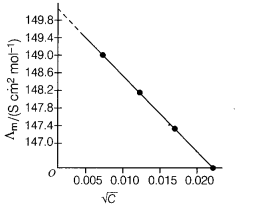
Here, the limiting molar conductivity is [1]
(a) 148.6
(b) 150
(c) 87.46
(d) 147
Answer:
(b) 150
When concentration
approaches zero, the molar conductivity is known as limiting molar conductivity.
So, here limiting molar conductivity is near about 150.
Question 4.
Identify A and B [1]
(a) A = Acetone , B = Methyl cyanide
(b) A = Hydrogen
cyanide, B = Formaldehyde
(c) A = Acetonitrile, B = Ethanal
(d) A =
Methanol, B – Methyl cyanide
Answer:
(b) A = Hydrogen cyanide, B =
Formaldehyde
Question 5.
Glycogen is a polymer of α-D-glucose stored in the [1]
(a)
liver, kidney and brain of animals.
(b) kidney, lungs and stomach of
animals.
(c) brain, liver and muscles of animals.
(d) stomach, muscles and
lungs of animals.
Answer:
(c) brain, liver and muscles of animals.
Glycogen is a polymer of a-D-glucose stored in the liver, brain and muscles of animals, also known as animal starch.
Question 6.
Match the magnetic moment with the ions of 3d-series. [1]
| (i) Cr2+ | (p) 5.92 BM |
| (ii) Mn2+ | (q) 3.87 BM |
| (iii) Fe2+ | (r) 4.90 BM |
| (s) zero |
(a) (i)-(r), (ii)-(q), (iii)-(p)
(b) (i)-(r), (ii)-(s), (iii)-(p)
(c)
(i)-(q), (ii)-(p), (iii)-(r)
(s) (i)-(s), (ii)-(r), (iii)-(p)
Answer:
(c) (i)-(q), (ii)-(p), (iii)-(r)
The number of unpaired electrons in Cr3+, Mn2+ and Fe2+ are 3, 5 and 4 respectively. By using formula for magnetic moment, i.e. µ = \(\sqrt{n(n+2)}\) where, n is number of unpaired electrons, the magnetic moment of Cr3+, Mn2+ and Fe2+ comes to be 3.87 BM, 5.92 BM and 4.90 BM respectively.
Question 7.
For the reaction, A → P, the rate of reaction increases eight
times when the concentration of the reactant increases four times. The order of
the reaction is [1]
(a) 2.5
(b) 0.5
(c) 1.5
(d) 2.0
Answer:
(c) 1.5
For the reaction, A → P
The differential rate law is
Rate =
k[A]x
Rate1 = k[a]x
Rate2 =
k[4a]x
Thus, \(\frac{\text { Rate }_2}{\text { Rate }_1}\) =
\(\left(\frac{4 a}{a}\right)^x\)
⇒ 8 = (4)x [∵ Rate2 =
8 Rate]
Taking log both sides
log 8 = log(4)x
⇒
log(2)3 = log(2)2x
⇒ 3log2 = 2 × log2
⇒ x =
\(\frac{3}{2}\) = 1.5
∴ Hence, order of the reaction is 1.5.
Question 8.
Which of the following statements is not correct for amines?
[1]
(a) The angle of C—N—C in trimethylamine is 108°.
(b)
Me—NH2 is the weaker base than MeOH.
(c) The amine formed has one
carbon atom less than the parent 1° amide in Hofmann bromamide reaction.
(d)
N-ethyl benzene sulphonamide is soluble in alkaline medium.
Answer:
(b)
Me—NH2 is the weaker base than MeOH.
MeNH2 is a
stronger base than MeOH because N is less electronegative than 0 and lone pair
of electrons on N is more easily available for the donation in
MeNH2.
Question 9.
What would be the product of the following reaction?
[1]
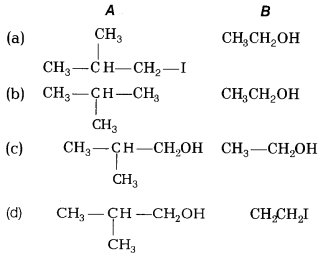
Answer:
(d)
The reaction of iso-propyl ethyl ether with hot hydroiodic
acid gives iso-propyl alcohol (A) and ethyl iodide (B).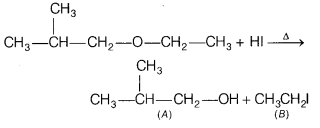
Question 10.
The half-life for a first order reaction is 240 s, the time
after which 99.9% reaction gets completed is [1]
(a) 16 min
(b) 8 min
(c) 32 min
(d) 40 min
Answer:
(d) 40 min
Given, half-life for a
first order reaction (t1/2) = 240 s = 4 min.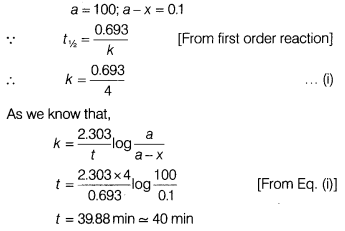
Question 11.
CH3CH2OH can be converted into
CH3CHO by [1]
(a) catalytic hydrogenation
(b) treatment with
LiAlH4
(c) treatment with pyridinium chlorochromate
(d)
treatment with KMnO4
Answer:
(c) treatment with pyridinium
chlorochromate
Ethanal is an oxidised product of ethanol.
Pyridinium chlorochromate
\(\left(\mathrm{PCC}=\mathrm{C}_6 \mathrm{H}_5 \stackrel{+}{\mathrm{N}}
\mathrm{H} \stackrel{-}{\mathrm{C}} \mathrm{ICrO}_3\right)\) oxidises primary
alcohols to aldehydes. It stops reaction at the aldehydic stage.
Strong
oxidising agents such as KMnO4 are used for getting carboxylic acids
from alcohols.![]()
Question 12.
Lanthanoides form complex with which of the following ligand?
[1]
(a) F–
(b) Br–
(c) Cl–
(d) None
of these
Answer:
(a) F–
F– have small size and
high electronegativity thus, it forms complex with lanthanides easily.
Direction (Q. Nos. 13-16) In the following questions as Assertion (A) is
followed by a corresponding Reason (R). Use the following keys to choice the
appropriate answer.
(a) Both (A) and (R) are true, (R) is the correct
explanation of (A).
(b) Both (A) and (R) are true, (R) is not the correct
explanation of (A).
(c) (A) is true, (R) is false.
(d) (A) is false, (R)
is true.
Question 13.
Assertion (A) Acetaldehyde on reaction with dil. NaOH forms
aldol.
Reason (R) Aldehydes and ketones having α-hydrogen undergo aldol
condensation. [1]
Answer:
(a) Both (A) and (R) are true and (R) is the
correct explanation of (A). Acetaldehyde has 3 α- hydrogen atoms, so can easily
undergo aldol condensation reaction.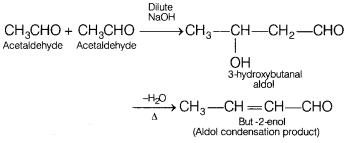
Question 14.
Assertion (A) Electrolysis of NaCl solution gives chlorine at
anode instead of O2.
Reason (R) Formation of oxygen at anode
requires over voltage. [1]
Answer:
(a) Both (A) and (R) are true and (R)
is the correct explanation of (A).
During the electrolysis of NaCl, the
following reactions take place.
The reaction with lower value of E° preferred, and therefore water should get
oxidised in preference to Cl–(aq). However, due to overvoltage,
chlorine is liberated at anode.
Question 15.
Assertion (A) Phenols give 0- and p-nitrophenol on nitration
with cone. HNO3 and H2SO4 mixture.
Reason
(R) —OH group in phenol is o – and p-directing. [1]
Answer:
(d) (A) is
false but (R) is true.
Phenols giveo- and p-nitrophenol on nitration with
dil. HNO3 at 298 K.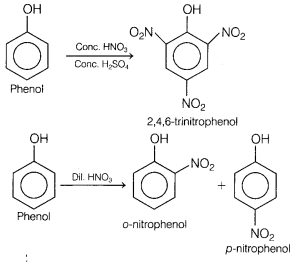
Question 16.
Assertion (A) All naturally occurring α-amino acids except
glycine are optically active.
Reason (R) Most naturally occurring amino acids
have L-configuration. [1]
Answer:
(b) Both (A) and (R) are true but (R) is
not the correct explanation of (A). All naturally occurring a-amino acids except
glycine are optically active.
Glycine is optically inactive because glycine
does not have all four different substituent as shown below.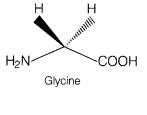
Section
B
(This section contains 5
questions with internal choice in one question. The following questions are very
short answer type and carry 2 marks each.)
Question 17.
(a) What is the difference between molarity and molality of a
solution? [2]
(b) A solution of glucose
(C6H12O6) in water is labelled as 10% by
weight. What would be the molality of the solution? (Molar mass of glucose = 180
g mol-1).
Answer:
(a) Molality is defined as the number of
moles of the solute present in per kilogram of the solvent. It is represented by
m. It does not change with change in temperature.
Molarity is defined as the
number of moles of solute dissolved in one litre or one cubic decimetre of the
solution.
It decreases with increase in temperature (as V ∝ T).
(b) A 10% glucose solution by weight means that 10 g glucose is present in
100 g solution.
Number of moles of 10 g glucose
= \(\frac{10}{180}\) =
0.0555 mol
Weight of glucose = 10 g
Weight of water = 90 g =
\(\frac{90}{1000}\)kg = 0.09 kg
Molality (m) \(=\frac{\text { Number of moles
of solute }}{\text { Mass of solvent (in kg) }}\)
= \(\frac{0.0555
\mathrm{~mol}}{0.09 \mathrm{~kg}}\)
= 0.61 mol kg-1 or 0.61 m
Question 18.
A first order reaction is 25% complete in 40 minutes.
Calculate the value of rate constant. In what time will the reaction be 80%
completed?
(Given : log 3 = 0.477, log 4 = 0.602) [2]
Answer:
For first
order reaction, k = \(\frac{2.30}{t}\) log \(\frac{a}{a-x}\)
The given first
order reaction completes 25% in 40 min.
Let, a = 100
a – x = 100 – 25,
a – x = 75
∴ k = \(\frac{2.303}{40}\)log\(\frac{100}{75}\)
=
\(\frac{2.303}{40}\)(log 4 – log 3)
k = 0.0072 min-1
For 80%
completion of reaction,
a = 100
a – x = 100 – 80 = 20
k = 0.0072
min-1
t = \(\frac{2.303}{0.0072}\)log\(\frac{100}{20}\)
= 223.6
min
Question 19.
(a) Explain why cyclohexanone forms cyanohydrin in good yield
but 2,2,6-trimethyl cyclohexanone does not.
(b) How will you obtain tertiary
butyl alcohol from acetone? [2]
Answer:
(a)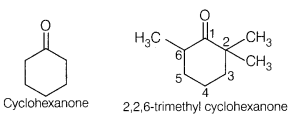
In 2,2,6-trimethyl cyclohexanone, three methyl groups are presents at a-position with respect to the ketonic \((>C=0)\) group. Therefore, these groups cause steric hindrance during the nucleophilic attack of CN– ion and cyanohydrin is not formed. Due to the absence of methyl groups in cyclohexanone, there is no steric hindrance and cyanohydrin is formed.
(b)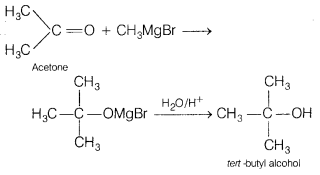
Question 20.
Give reason for the following.
(a) t-butyl bromide is more
reactive towards SN1 reaction as compared to n-butyl bromide.
(b)
CH3CH2I undergoes SN2 reaction faster than
CH3CH2Br. [2]
Or
(a) A hydrocarbon C5H12 gives only one monochlorination
product. Identify the hydrocarbon.
(b)
Out of![]()
and![]()
which one undergoes faster towards SN1 reaction?
[2]
Answer:
(a) In SN1 reaction, reactivity depends upon the
stability of intermediate carbocation formed. Let us consider the formation of
carbocation of the two given alkyl halides.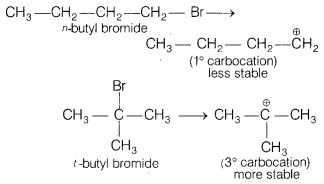
Carbocation formed by tert-butyl bromide being tertiary is more stable than
primary, hence t-butyl bromide undergoes SN1 reaction faster.
(b) As I– ion is a better leaving group than Br ion, therefore iodides are more reactive than bromides. Therefore, CH3—CH2—I is more reactive than CH3—CH2—Br towards SN2 reaction and thereby, CH3—CH2—I would undergo SN2 reaction faster than CH3—CH2—Br.
Or
(a) Hydrocarbon which gives only one
monochlorination product is 2,
2-dimethylpropane.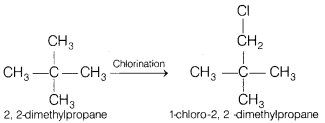
(b) The reactivity towards SN1 reaction depends upon the stability
of the intermediate carbocation which an alkyl halide gives on ionisation.
Thus,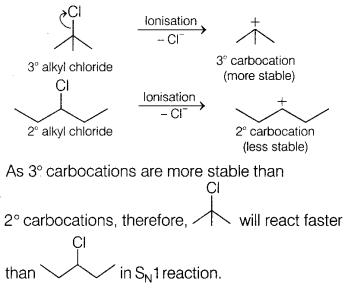
Question 21.
(a) Amino acids show amphoteric behaviour. Justify your
answer.
(b) Explain what is meant by pyranose structure of glucose? [2]
Answer:
(a) Amino acids contain both amino (—NH2) and carboxyl
(—COOH) groups, thus they react with both acids and bases. Hence, amino acids
are amphoteric in nature.
(b) The six membered cyclic structure of glucose is
called pyranose structure (α or β), in analogy with pyran. Pyran is a cyclic
compound with one oxygen atom and five carbon atoms in the ring.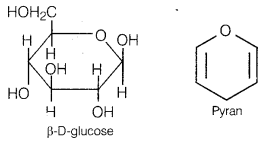
Section
C
(This section contains 7
questions with internal choice in one question. The following questions are
short answer type and carry 3 marks each.)
Question 22.
(a) By giving an example, explain the use of complex
compounds in qualitative analysis.
(b) Write the formula for the following
coordination compound.
Iron (III) hexacyanidoferrate (II)
(c) Explain why
are low spin tetrahedral complexes not formed. [3]
Answer:
(a) EDTA
reagent forms various coloured hybrid compounds with many metal ions (such as
Ca2+, Ca, Zn2+, Fe2+, CO2+,
Ni2+ etc.) which are used to identify these metal ions. (1)
(b)
Fe4[Fe(CN)6]3.
(c) For tetrahedral
complexes, the crystal field stabilisation energy is lower than pairing energy,
so they are not formed in low spin state.
Question 23.
(a) Explain strong and weak electrolytes with examples.
(b) Calculate the emf of the cell.
Mg(s)|Mg2+ (0.1M) | |
Cu2+ (1 × 10-1M) |Cu(s)
(c) Arrange the following metals in the order in which they
displace each other from the solution of their salts Al, Cu, Fe, Mg and Zn.
[3]
Answer:
(a) Strong electrolytes These electrolytes are those
completely dissociate into ions at all concentrations, e.g. NaOH, NaCl, KCl
etc.
Weak electrolytes The electrolytes which do not ionise completely in aqueous as well as in molten state are called weak electrolytes, e.g. H2CO3, HgCl2, CH3COOH etc.
(b)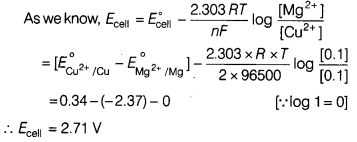
(c) Mg > Al > Zn > Fe > Cu
Question 24.
Write the reaction and IUPAC name of the product formed.
(a) When ethanal is treated with ethyl magnesium bromide followed by
hydrolysis.
(b) Phenol is treated with conc. H2SO4 and
conc. HNO3. [3]
Answer:
(a) When ethanol is treated with ethyl
magnesium bromide, then unstable compound is formed which further on hydrolysis,
gives final product, i.e. butan-2-ol.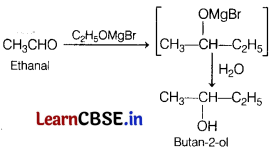
(b) When phenol is treated with conc. H2SO4 and cone.
HNO3, the nitration of phenol takes place and 2, 4, 6-trinitrophenol
is obtained.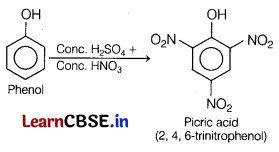
Question 25.
An organic compound A
(C4H6O4) on treatment with ethyl alcohol gives
a carboxylic acid B and compound C. Hydrolysis of C under acidified conditions
gives B and D.
Identify A, B, C and D and write all the involved equations.
[3]
Or
A ketone ‘A’ (C4H8O) which undergoes a haloform
reaction gives compound B on reduction, heating with sulphuric acid gives a
compound C which forms mono-ozonides D. Identify A, B, C and D and write all the
involved equations. [3]
Answer: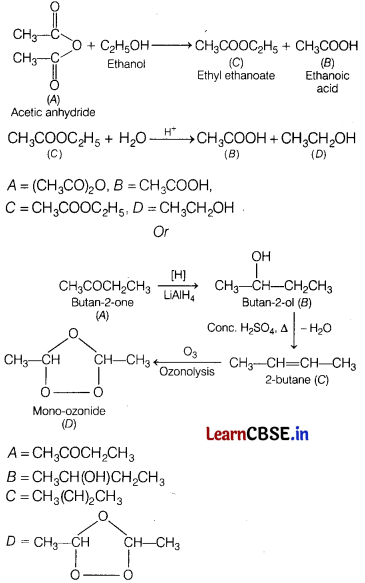
Question 26.
The three solutions of fructose, sucrose and glucose are
prepared in 10% water at 2d°C. The optical rotation values are measured by the
student using a polarimeter and are given in the following table. [3]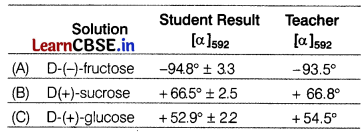
(a) What does the positive and negative optical rotation in the above results
indicate?
(b) There can be a change in the sign of rotation from dextro to
laevo in a reaction. Justify your answer with example.
(c) If glucose reacts
with acetyl chloride or acetic anhydride, then compound A is obtained. Identify
the compound A.
Answer:
(a) For clockwise direction, the optical rotation
(in degrees) is defined as positive and called dextrorotatory. In contrast, the
counterclockwise direction is defined as negative and called laevorotatory.
(b) When hydrolysis of sucrose takes place, there is a change in the sign of
rotation from dextro to laevo, because of the change in optical rotation.
(c)
The reaction of glucose with acetyl chloride or acetic anhydride gives glucose
pentaacetate, i.e. compound A.
Question 27.
Name the possible alkene which will yield toluene on their
reaction with sodium and methyl chloride. Write the name of reaction involved
and its mechanism also. [3]
Answer: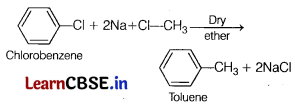
Chlorobenzene reacts with sodium and methyl chloride in the
presence of dry ether to form toluene and sodium chloride. This reaction is
known as Wurtz reaction.
Mechanism involved :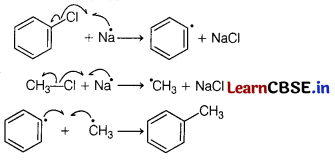
Question 28.
A first order reaction is 20% complete in 10 minutes. Find
the time required for 75% completion of the reaction. [3]
Answer:
For the
first order reaction,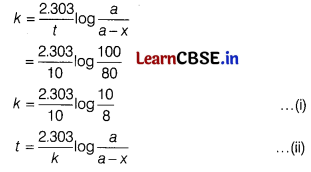
By substituting value of k from Eq. (i) in Eq. (ii),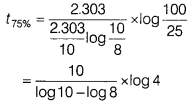
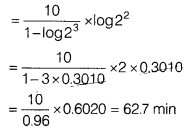
Section
D
(The following questions are
case-based questions. Each question has an internal choice and carries 4(1+1+2)
marks each. Read the passage carefully and answer the questions that
follow.)
Question 29.
Relationship between Wavelength and Colour of Coordination
Compounds
The colour of light is determined by the amount of valence
electrons present in a compound’s outermost orbit. These electrons absorb a
certain wavelength of visible light and emit a colour that is complementary to
the wavelength absorbed. The colour for a coordination complex can be predicted
using the Crystal Field Theory (CFT). The table given below shows the different
wavelength absorbed by the coloured complexes.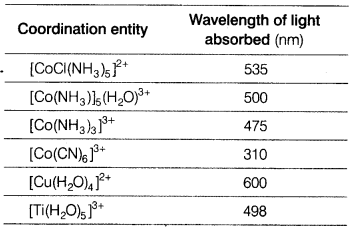
Answer the following questions. [4]
(a) Among the given complexes, which have the strong held ligand and give the IUPAC name of that complex?
Or
Out of the ligands attached to the given complexes, which will cause maximum
splitting and why?
(b) Which of the given compounds is pale yellow in colour
?
(c) What is spectrochemical series and arrange the mentioned ligands (in
the table) according to spectrochemical series?
Answer:
(a)
\(\mathrm{CN}^{-} \text {in }\left[\mathrm{Co}(\mathrm{CN})_6\right]^{3-}\) is a
strong field ligand and IUPAC name of this complex is
hexacyanidocobaltate(III).
Or
As CN– is a strong field ligand, hence it will cause maximum
splitting. [4]
(b) [Co(CN)6]3- is the most stable
complex, thus it absorbs light of minimum wavelength. Hence, it has lightest
colour, i.e. pale yellow.
(c) Spectrochemical series is the series which
gives the arrangement of ligands in the increasing order of crystal field
splitting.
The order from weak to strong ligands according to spectrochemical
series is
Cl– < H2O < NH3 < CN.
Question 30.
A knowledge of the electrode potential is of utmost
importance in order to design any electrochemical device or to carry out any
meaningful measurement. The reactions carried out electrochemically can be
energy efficient and less polluting. Therefore, study of electrochemistry is
important for creating new technologies that are ecofriendly. To know about the
electrochemistry, the related terms should be known. A potential difference
develops between the electrode and the electrolyte which is called electrode
potential. When the concentrations of all the species involved in a half-cell is
unity then the electrode potential is known as standard electrode potential.
The redox reaction that occurs during an electrochemical process.The oxidation-reduction reactions take place in two half-reactions, one representing the oxidation process and’one the reduction process. The sum of the half-reactions gives the overall chemical reaction. Single electrode potential cannot be determined. An electric current is produced from the flow of electrons from the reductant to the oxidant. An electrochemical cell can either generate electricity from a spontaneous redox reaction or consume electricity to drive a non-spontaneous reaction. In a galvanic (voltaic) cell, the energy from a spontaneous reaction generates electricity, whereas in an electrolytic cell, electrical energy is consumed to drive a non-spontaneous redox reaction. Both types of cells use two electrodes that provide an electrical connection between systems that are separated in space.
The oxidative half-reaction occurs at the anode, and the reductive
half-reaction occurs at the cathode. A salt-bridge connects the separated
solutions, allowing ions to migrate to either solution to ensure the system’s
electrical neutrality. A voltmeter is a device that measures the flow of
electric current between two half-reactions.
The potential of a cell,
measured in volts, is the energy needed to move a charged particle in an
electric field.
Answer the following questions. [4]
(a) Following reactions occur at cathode during the electrolysis of aqueous
silver chloride solution :
Ag+(ag) + e– → Ag(s);E° =
+0.80V
H+(aq) + e– → \(\frac{1}{2}\)H2(g);
E° = 0.00V
On the basis of their standard reduction electrode potential (E°)
values, which reaction is feasible at the cathode and why?
(b) What does the
positive value of standard electrode potential indicate?
(c) You have two
half-cell reactions of an electrochemical cell are given below.
Imagine you are a member of scientific research working on electrochemistry
project. Construct the redox equation from the two half-cell reactions and
predict if this reaction favours formation of reactants or product shown in the
equation.
Or
Give your comments on the following statement and justify your views.
(i)
Single electrode potential cannot be determined.
(ii) An electrochemical cell
act as electrolytic cell.
Answer:
(a) At the cathode, Ag+(ag) +
e– → Ag(s)
reaction is feasible, because Ag+ ion has
higher reduction potential, i.e. higher E° value.
(b) The positive value of
standard electrode potential indicates that the element gets reduced more easily
than H+ions and its reduced form is more stable than hydrogen
gas.
(c) The reactions can be represented at anode and at cathode in the
following ways.
At anode (oxidation):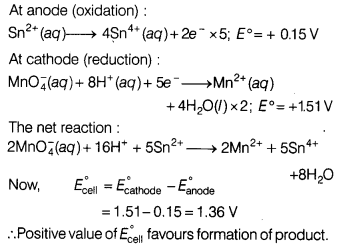
Or
(i) A single half-cell does not exist independently as reduction and
oxidation occur simultaneously, therefore single electrode potential cannot be
measured.
(ii) An electrochemical cell can be converted into electrolytic
cell by applying an external opposite potential greater than its own electrical
potential.[4]
Section
E
(The following questions are
long answer type and carry 5 marks each. All questions have an internal
choice.)
Question 31.
Attempt any five of the following. [5]
(a) Why is the
highest oxidation state is exhibited in oxo-anions of transition metals?
(b)
Why the transition elements show high melting points?
(c) Why first
ionisation enthalpy of Cr is lower than that of Zn?
(d) Explain the
observation, although Cr3+ and Co2+ ions have same number
of unpaired electrons but the magnetic moment of Cr3+ is 3.87 BM and
that of Co2+ is 4.87 BM.
(e) What are the misch metals?
(f)
Actinoids show large number of oxidation states than lanthanoids. Explain.
(g) What happens when a lanthanoid reacts with water?
Answer:
(a) The
ability of oxygen to form multiple bonds with metal responsible for the high
oxidation state of metal in oxoanions.
(b) Transition elements show high
melting point, due to involvement of greater number of electrons in the
interatomic bonding from (n- 1)d-orbitals in addition to ns-electrons.
Thus,
they have large number of unpaired electron which are responsible for high
strength of metallic bond.
(c) Ionisation enthalpy of Cr is less than that of
Zn because Cr+ has stabled5 configuration. In case of
zinc, electron comes out from completely filled 4s-orbital.
So, removal of
electron from zinc requires more energy as compared to the chromium. (1)
(d)
Magnetic moment of any metal ion can be decided on the basis of spin as well as
orbital contribution of electron.’ Due to symmetrical electronic configuration,
there is no orbital contribution in ion. However, appreciable orbital
contribution takes place in Co2+ion.
(e) Misch metal is an alloy
which consists of a lanthanoid metal (~95%) and traces of S, C, Ca and Al. It is
used in Mg based alloy to produce bullets, shell and lighter-flint.
(f)
Because in actinoids, 5f-orbitals are filled which are not as buried as
lanthanoids and also participate in bonding to a greater extent besides 6d and
7s electrons.
(g) When a lanthanoid reacts with water, it forms
hydroxide.
Ln + H2O → Ln(OH)3 + H2
Question 32.
(a) Explain why people feel weakness and discomfort in
breathing at high altitude.
(b) Gautam have different solutions in two
containers, 1M NaOH solution in one container and 1M
Na2SO4 solution in second container. Help him to identify
which container’s solution will have high boiling point.
(c) At 27°C, 25 mg
of K2SO4 was dissolved in 2 L solution. Find out its
osmotic pressure. Taking into consideration that K2SO4 has
dissociated completely.
(R = 0.082 L atm K-1 mol-1)
[5]
Or
(a) What do you understand by elevation of boiling point? How it is related
to molality?
(b) Heptane and octane form an ideal solution. At 373 K, the
vapour pressure of the two liquid components are 105.2 kPa and 46.8 kPa
respectively. What will be the vapour pressure of a mixture of 26.0 g of heptane
and 35 g of octane ? [5]
Answer:
(a) At high altitude atmospheric pressure
is low as compared to surface which causes difficulty in breathing. In this
condition, people feel weakness and discomfort.
(b) As we know greater the
value of van’t Hoff factor, higher will be the elevation in boiling point and
hence, higher will be the boiling point of solution.
(c) Given : Mass of
solute (w2) = 25 mg = 25 × 10-3 g
Volume of solution = 2 L
Temperature (T) = 273 + 27 = 300 K
R = 0.082 L atm
K-1mol-1
∴ π = \(\frac{i \times W_2 \times R T}{V
\times M_2}\)
π = \(\frac{3 \times 25 \times 10^{-3} \times 0.082 \times
300}{2 \times 174}\) (∵ i = 3)
= 0.0053 atm
Or
(a) Elevation of boiling point (∆Tb) On mixing, any non-volatile
solute in solvent, the vapour pressure of solution decreases. As a result,
boiling point of solution increases. The increase in boiling point of a solvent
is known as elevation in boiling point (∆Tb). In mathematical form,
∆Tb = Ts – T0
where, Ts and
T0 is boiling point of solution and solvent.
Relationship between
elevation in boiling point and molality
Elevation in boiling point =
Kb × molality where, Kb = molal elevation constant.
(b) Number of moles of octane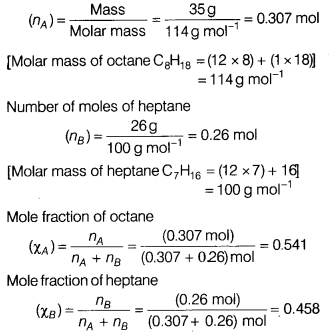
Vapour pressure of pure heptane (\(p_B^{\circ}\)) = 105.2 kPa
Vapour pressure
of pure octane (\(p_A^{\circ}\)) = 46.8 kPa
In the mixture of 26.0 g heptane
and 35.0 g octane
(i) Vapour pressure of heptane (pB) = p°B
xB
= (105.2 kPa × 0.458)
= 48.18 kPa
(ii) Vapour pressure of octane
(pA) = P°A
χA = (46.8 kPa × 0.541) = 25.32 kPa
(iii) Total vapour pressure of the mixture (p) = p°B +
p°B
= 25.32+ 48.18= 735 kPa
Question 33.
Write structures of different isomers corresponding to the
molecular formula, C3H9N. Write IUPAC names of the isomers
which will liberate nitrogen gas on treatment with nitrous acid. [5]
Or
(a) Account for the following. [5]
(i) Methylamine is more basic than
ammonia.
(ii) —NH2 group of aniline is acetylated before carrying
out nitration.
(b) Arrange the following.
(i) In the decreasing order of
the pKb values:
C2H5NH2,
C6H5NHCH3,
(C2H5)2NH,
C6H5NH2
(ii) In increasing order of basic
strength: C6H5NH2,
C6H5N(CH3)2,
(C2H5)2NH, CH3NH2
(iii) In increasing order of basic strength: Aniline, p-nitroaniline,
p-toluidine.
Answer: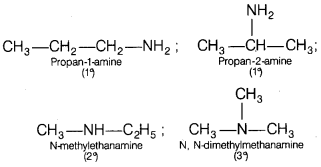
Only primary amines (1°) which are mentioned above will liberate nitrogen gas on
treatment with nitrous acid.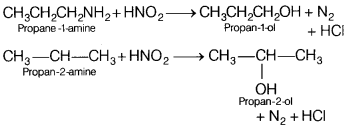
Or
(i) Methylamine a stronger base than ammonia, since it has an electron
donating group. Therefore, electron density on nitrogen atom increases. Hence,
it is stronger base, whereas in ammonia electron donating group is absent.
(ii) In order to check the activation of benzene ring by amino group, first it
is acetylated with acetic anhydride or acetyl chloride to form acetanilide which
can be further nitrated easily by nitrating mixture.
(b) (i) C6H5NH2 >
C6H5NHCH3
>C2H5NH2 >
(C2H5)2NH
(The smaller pKb, the
stronger is the base).
(ii) C6H5NH2 <
C6H5N(CH3)2 <
CH2NH2 < (C2H5)2NH
(On the basis of +R effect and accepting ability)
(iii) p-nitroaniline <
aniline < p-toluidine
(On the basis of EWG or EDG attached to benzene
ring.).